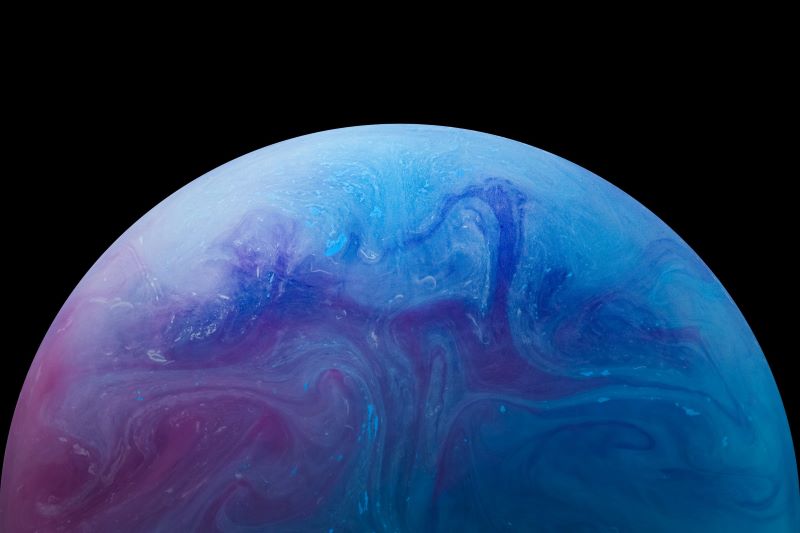
New evidence for planet 9
There is growing speculation that a planet the size of Neptune – Planet 9 – is lurking deep on the outskirts of our solar system. Researchers from the California Institute of Technology, the University of the Cote d’Azur and the Southwest Research Institute shared a preprint on April 17, 2024. In it, they argue that a group of small bodies beyond Neptune are being thrown together by the gravitational pull of Planet 9. These distant Solar System bodies are not uniformly distributed in their orbits, like the rocky boulders of the asteroid belt. Instead, they form unwieldy groups. Therefore, the researchers believe that a larger, more distant object is gravitationally pulling them into this pattern. And, actually, this is how the eighth planet was discovered – Neptune. Neptune moved in the orbit of Uranus.
Two of the four authors of the new paper, Konstantin Batygin and Mike Brown of the California Institute of Technology, are the creators of the Planet 9 theory. Mike Brown wrote a book about his life and research in the far reaches of our solar system, including the reclassification of Pluto. The book is called How I Killed Pluto and Why It Happened. But these researchers believe there is an object much larger than Pluto further out in our solar neighborhood. This planet would be the size of five Earths (about the size of Neptune) and would lie 400-800 times farther from the sun than Earth.
Astrophysical Journal Letters accepted the article for publication. It has not been reviewed yet. A copy of the paper is available on arXiv.
Help spread the wonders of astronomy! Donate to EarthSky.org and make sure people around the world can learn about the night sky and our universe.
Batygin on the Event Horizon podcast
Batygin said on the John Michael Godier Event Horizon podcast that:
… the fifth and most statistically significant evidence for the existence of Planet 9 that we have to date.
Batygin also said:
What we have considered in this paper is a population of trans-Neptunian objects that we have ignored until now. These are populations of long-lived icy asteroid-like creatures that normally live beyond the orbit of Neptune … but have orbits that pierce Neptune’s orbit. We also specifically looked at the population of Neptune crossers that live close to the plane of the solar system.
So, as the objects cross Neptune’s orbit and are jostled by the giant planet, if left alone they would drift apart. As Batygin said:
The fact that we see them at all requires some form of gravitational influence. … What we show in this paper is that not only is Planet 9 up to the task, but that the orbital distribution that Planet 9 predicts is completely consistent with what we see in the data.
In fact, Batygin said that a Solar System without Planet 9 can be ruled out with five sigma confidence. This value is considered sufficient for fields such as particle physics to claim a discovery. This is the “gold standard” of about a one in a million chance that the result was random.
Planet 9, galactic tide or black hole?
Are there any theories other than Planet 9 that could explain the grouping of trans-Neptunian objects? One of these theories concerns the galactic tide. And the researchers looked at this gravitational pull from the galaxy itself. But they found that some features of the distribution of objects could not be reproduced by the galactic tide. However, the Planet 9 theory fits perfectly.
Another theory not discussed in the article is that Planet 9 could be a black hole. If black holes roam the distant solar system, Harvard astronomer Avi Loeb has proposed a way to find them. They will look for flares from black hole collisions with small, distant objects.
The upcoming Vera Rubin Observatory may just be the tool to obtain important data to solve the mystery of Planet 9 or the black holes of the Solar System. The telescope should be launched by early 2025.
Unfortunately, new data from a recent study doesn’t help us find a direction to point our telescopes to see Planet 9. So the hunt continues.
Announcement on social networks
Here’s how lead author Konstantin Batygin announced the discovery on social media:
A key early clue for Planet 9 came nearly a decade ago: Kuiper belt objects with high perihelion cluster together. Gravitational scattering from Neptune breaks this regime, so the focus has remained on dynamically stable (Sedno-like) TNOs, ignoring unstable ones. pic.twitter.com/YNZ0Yrauy3
— Konstantin Batygin (@kbatygin) April 18, 2024
Given their dynamical instability, only two scenarios can sustain this TNO population in a steady state: they are either driven inward by the interaction between the Galactic tide and Neptune’s scattering, or they are the result of the dynamics caused by Planet 9 (as shown in the figure). pic.twitter.com/HBEqm0UO9J
— Konstantin Batygin (@kbatygin) April 18, 2024
But what about observation bias? After adjusting for this, the data favors the Planet 9 model at an astonishing 5 sigma level. Surprisingly, this “non-exotic” TNO group provides the strongest statistical evidence that Planet 9 actually exists… pic.twitter.com/LksVpOyfS1
— Konstantin Batygin (@kbatygin) April 18, 2024
Bottom line: Researchers say a group of small objects orbiting Neptune is entirely consistent with the existence of Planet 9, which lurks on the outskirts of our solar system.
Source: Creating low-inclination TNOs crossing Neptune, the ninth planet
Via Event Horizon